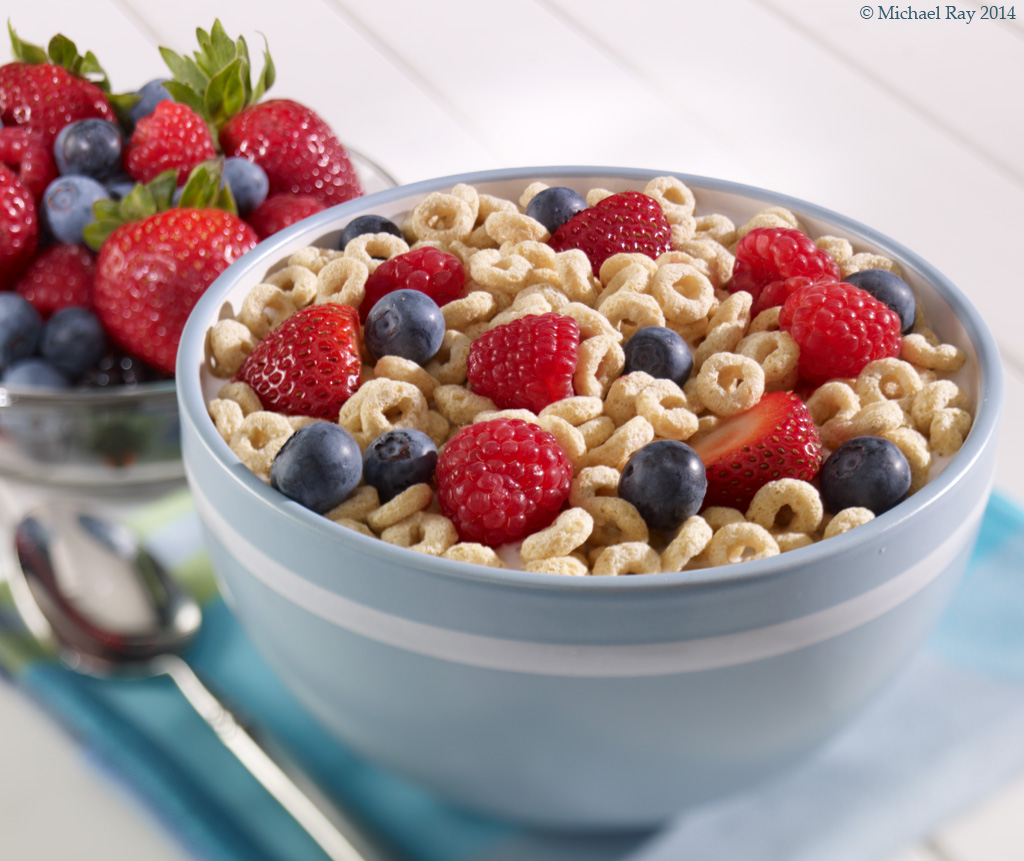
I shot this un-retouched food photo with my 6×9 view camera. You can see how the focus has been manipulated to give the image a very unique feel. Even with a tilt shift lens on my DSLR, you just can’t get this type of effect. But having said that, is it really worth the price…?
A food photographer’s opinion about what makes the best food photography camera
This isn’t an article about which is better Canon or Nikon, it’s about 35mm DSLR, medium format, or view camera. Like most other professional photographers, I have my own biases, but unlike many others, I’ve used all three types of cameras. So after many years of being not only a professional photographer, but a professional food photographer, I feel I have an insight into the pros and cons of each type of camera and which tends to work better when it coms to shooting food.
First, lets compare the 35mm DSLR to the medium format. The advantages that the medium Format camera have is in “dynamic range”, or detail. Even though the file size between the cameras may be the same, the medium format camera has more detail than the 35mm DSLR. Of course, as technology improves the difference will most likely become less and less, but for now, that’s a simple fact. Now whether you can see the difference between the two, that’s a different story. At the time of this article the differences are not all that much, especially if your final use for the images are on the web as opposed to print. If you need for the food photography is for the web, then the detail difference would not even be noticeable.
The 35mm DSLR has several advantages over the medium format digital camera. Probably the biggest advantage is price. A good quality 35mm DSLR is much cheaper and so are many of the lenses. If you can count on similar quality, then why not go with the cheaper option?
Another advantage that DSLR cameras have in food photography is that there are more lens options. Nikon, for example offers several different types of lenses capable of focusing in close enough to make them useful for food photography, while most medium format camera have only one of two. If you’re a professional food photographer, or even an advanced amateur, it’s nice to have different perspectives available to add to your creative options.
Another big advantage a 35mm DSLR has over the medium format camera is the availability of perspective control lenses. I’m not aware of any medium format lenses available that will allow the manipulation of the “plane of focus”. “Tilt Shift”, or “Perspective Control” lenses, available with 35mm DSLR cameras, allows more options to control the focus of you food photos. I’ll write another blog post about the use of PC or TS lenses and another time.
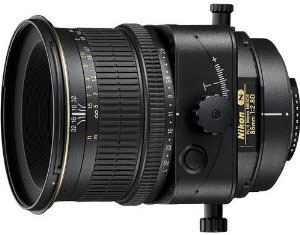
When I shoot food with my DSLR, this is the lens I use 99% of the time… A macro tilt shift lens give you some of the flexibility of a view camera with the speed of use of the dslr. It’s almost the best of both worlds… (Nikon 85mm 2.8 TS marco lens)
“Speed of use” is another thing that the 35mm DSLR camera has over the medium format. The lenses tend to be smaller and lighter and since a food photography camera tends to be on a tripod most of the time, that’s not a huge advantage, but it’s worth considering…
So to sum up the difference between medium format digital cameras and DSLR cameras for work in food photography, I’d say that the DSLR has the hands down advantage in most respects.
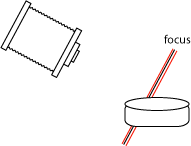
This illustration, even though it shows a view camera, shows you the only possible focus plane (without a tilt shift lens) you have with a dslr.
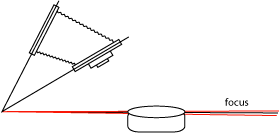
But when photographing food with a view camera, you can manipulate the plane of focus to give you more or less focus, depending on your creative wants of needs…
View camera or DSLR for food photography?
In my mind, at least, the medium camera is not a very good option when it comes to food photography, so lets now compare the DSLR to the view camera and see how each stacks up. I have confess here that I use both cameras to photograph food. I have an Arca Swiss 6×9 view camera with a Phase One P45 digital back that I use to shoot food in the studio and a Nikon D800 with an 85mm tilt shift macro lens, that I use for location food photography. Until recently, I’ve even been taking the view camera on location, but I’ve come to the conclusion that the 35mm is just too easy to setup and use, compared to the Arca, for location work.
Here are the advantages and disadvantages of the DSLR.
1. Price – The D800 goes for about 2800 dollars and the 85mm TS macro lens is probably about another 1500. In the near future, I’d like to buy the 45mm TS macro lens, but don’t have it yet. That sucker cost another 1800. So if I add another thousand for a couple of miscellaneous lenses to that… For 7-8 thousand dollars, I can have a great food photography setup that will allow me to shoot pretty much any food shot I may need that comes my way. On the other hand, my view camera cost me about 5-6 thousand bucks and the digital back was 30,000.00 new!!!!!!!!!!!!!!!!! That’s a LOT more money and when it comes time to replace the camera back, for whatever reason, it’s going to be awfully hard to justify that amount of money. And we haven’t talked about the lenses yet either. So, the big advantage in price goes to the DSLR.
2. Versatility – Even though the DSLR has tilt shift lenses available, the view camera can make any of its lenses into a tilt shift lens, and a macro lens, too. If you want to tilt the lens to get more focus, you just do it. If you want to focus in closer, you just do it. You’re not limited by the lens. It’s great and there’s no better way to shoot food.
3. Speed of Use – Frankly, a view camera is a pain in the butt to use. If you do want to focus in lighter, you might need to switch bellows or if you want to use a long lens, you might need to add an extension rail. To even focus, you need to close down the lens and to use a magnifying glass and focus using the camera’s ground glass. Then, you need to close the lens before you shoot. It’s a pain, and the 35mm lens is soooooo much faster.

Here’s a behind the scenes shot of my view camera in action. If you look closely, you can see that the front standard is tilted slightly forward, giving me a plane of focus that will make both the front and the back of the photo sharp.
4. Image Quality – On my view camera, I have a medium format digital back, so the images quality does surpass the quality of the 35mm DSLR, and there’s no doubt about that. But… it’s getting harder and harder to distinguish the quality difference. Another advantage that the view camera has over the dslr, is that since the medium format chip is bigger than that of the DSLR, it requires a longer lens to give it the same perspective. What this does is makes the focus “fall off” quicker giving a very pleasing effect, when used in a minimum focus situation.
Conclusion: What camera is best for food photography? I’d have to give the edge to the view camera, but for and investment of 40,000, for camera, back and lenses, I’d say that if was was just starting out today doing food photography, I’d go with the DSLR, and spend the difference on a few nice vacations… :o)


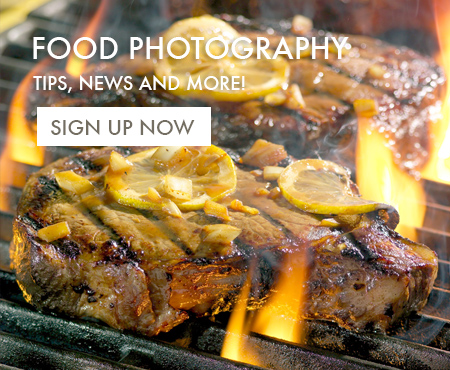
Michael,
“and a Nikon D800 with an 80mm tilt shift macro lens, that…”
Edit to correct that to 85mm.
I, too, over the years have used digital, 35mm film, medium format (RB-67) and large format (4×5″) cameras.
I would have thought a Phase One back on your 6×9 would have been an ideal combination. I had been thinking of getting a used digital back to put on one of my Cambo cameras.
Have you tried putting your DSLR on the back of your 6×9 camera that has a 90mm lens mounted on it? Of course a bag bellows would be needed in order for the camera body to be close enough but that shouldn’t be an issue.
Cambo makes something you might want to look into. Their X2-Pro system is designed for a digital back or DSLR and gives you movements via the bag bellows.
http://www.cambo.com/Html/products_photo/set01/english/internet/Item752.html
Keep in touch.
Terry Thomas…
the photographer
Atlanta, Georgia USA
Terry, Thanks for the correction. The problems with the digital back is that it’s soooooo darn expensive. I love the way it works, and I already had all the lenses from my view camera days, but it is a bit slower to use and the 35 stuff is getting better and better all the time. I don’t think that the dslr lens mount would work very well. I just don’t see being able to get the lens close enough to the body to be of any good. It might work, but my system is working now, so why buy shit I don’t really need? Maybe when it breaks… :o)
Michael,
Here is a medium format camera that offers lens movements:
The Fuji GX680
http://www.photigy.com/technical-medium-format-camera-fuji-gx-680-review/
Terry
Wow, that’s pretty cool, but you really need the lenses to go with it. If you make the moves, the lens better be sharp on the edges. My “normal” (most used) 120mm Super Angulon lens is actually designed for an 8×10 view camera.
What a great read, you are a store house of information, Just to watch you do your magic will be a great learning experience. Thanks for taking the time to write articles like this to help newbies like me.
You’re pretty damn good for a newbie… :o)